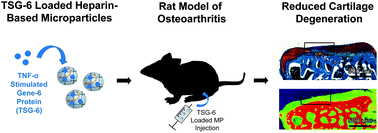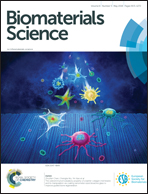Intra-articular TSG-6 delivery from heparin-based microparticles reduces cartilage damage in a rat model of osteoarthritis†
Abstract
As a potential treatment for osteoarthritis (OA), we have developed injectable and hydrolytically degradable heparin-based biomaterials with tunable sulfation for the intra-articular delivery of tumor necrosis factor-alpha stimulated gene-6 (TSG-6), a protein known to inhibit plasmin which may degrade extracellular matrix within OA joints. We first assessed the effect of heparin sulfation on TSG-6 anti-plasmin activity and found that while fully sulfated (Hep) and heparin desulfated at only the N position (Hep−N) significantly enhanced TSG-6 bioactivity in vitro, fully desulfated heparin (Hep−) had no effect, indicating that heparin sulfation plays a significant role in modulating TSG-6 bioactivity. Next, TSG-6 loaded, degradable 10 wt% Hep−N microparticles (MPs) were delivered via intra-articular injection into the knee at 1, 7, and 15 days following medial meniscal transection (MMT) injury in a rat model. After 21 days, cartilage thickness, volume, and attenuation were significantly increased with soluble TSG-6, indicating degenerative changes. In contrast, no significant differences were observed with TSG-6 loaded MP treatment, demonstrating that TSG-6 loaded MPs reduced cartilage damage following MMT injury. Ultimately, our results indicate that Hep−N can enhance TSG-6 anti-plasmin activity and that Hep−N-based biomaterials may be an effective method for TSG-6 delivery to treat OA.


 Please wait while we load your content...
Please wait while we load your content...
